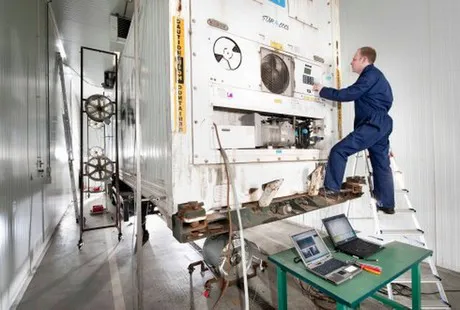Transport and quality is often a challenging combination. A good product can arrive in Europe as a bad product after several weeks at sea. Various options can be employed to retain the quality of the products. Wageningen Food & Biobased Research recently added a new option: dry ice as a source of high CO2 levels in the transport and storage of soft fruit. A partner is now needed to market the product.

“We wanted to create a high CO2 in a transport container, reefer or lorry to protect the product in the container against decay,” says Eelke Westra, researcher post-harvest technology of Wageningen Food & Biobased Research. We looked for an alternative to SO2, which is CO2. Besides, we also looked for a way to easily keep the CO2 at a high concentration. This became the use of dry ice. It’s mostly about protecting against moulds or other quality defects that can be prevented with a high CO2.”
High CO2 an alternative to SO2The Dutch research team got the request for an alternative source of CO2 from the market. For the transport of grapes, increasing the CO2 in the container is relevant to combat botrytis. “Pads impregnated with SO2 are now used to that end, but there’s a chance Europe will prohibit the use of these. Besides, some people are allergic to these. That’s why we received the request for an alternative from business,” Eelke says. Another disadvantage of SO2 pads: when the dosage is too high, it can damage the fruit. It only becomes clear the dosage was too high in hindsight, because the fruit loses colour. “That was the reason for us to research high CO2 in containers, and because we already knew dry ice could be a source, we also kept that in mind during the study.”
The conventional method of creating a high CO2 level in a container is by first using nitrogen to dispel oxygen, after which the CO2 is blown into the container. The container is then made gas-proof, “and then we hope the CO2 content in the container remains high during the entire transport, because no CO2 cylinders are placed on the container.” The researchers chose to look for a source of CO2 in the container. “Products breathe, but not all products produce enough CO2. You need a source in the container for that,” Eelke explains. A CO2 cylinder could be a solution, but dry ice, the solid form of CO2, is another option. It’s an affordable option as well. A careful estimate is 200 to 400 euro per container.
Grape, redcurrant, blueberry…
But what is the advantage of dry ice compared to a CO2 cylinder? “It can be placed in the container at the beginning of the supply chain, so you don’t have to wait until the container arrives at the place where the CO2 cylinder is. Because of that, the trajectory with a high CO2 is longer,” Eelke says. Besides, the leak tightness of the container becomes less decisive. People assume containers are leak tight, but that’s checked as a standard. “We didn’t research that either, but we know desired CO2 concentrations aren’t always achieved,” he continues.
Although the research question came from the field of grapes, other products, such as redcurrant and blueberry, are also transported using high CO2 levels. Some types of fruit breathe more than others and emit a lot of CO2. About 20 per cent CO2 can be realised that way. “The product produces its own CO2 then,” Eelke clarifies. Grapes and blueberries don’t breathe enough to achieve a high percentage. “A CA container doesn’t blow CO2 into the container. You’d need an alternative source of CO2.”
“The study mostly focused on the technical aspect to keep the CO2 level high for longer periods,” Eelke says. Depending on the amount of dry ice placed in the container, the container could have high CO2 levels for two to three weeks. The study was finished a year ago, and a patent was applied for. “The grape importers we worked with are mostly interested in the quality of the grapes,” Eelke concludes. “They won’t be marketing the product, but they do want to use it. The project is in a stage of continued development, and we’re looking for market parties such as logistical service providers who want to work together to market the service.”
For more information:
eelke.westra@wur.nl
paul.goethals@wur.nl
www.wur.nl/wfbr
